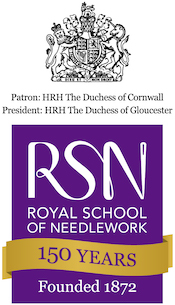Go back in time to learn about the role of flowers in embroidered objects throughout the 18th century with RSN Collections volunteer Sophie Leathart as she uses her expert flower knowledge to chart how trends changed over the course of decades. This blog post illustrates how garden styles, floristry, and stitch were affected by the shift from Baroque to Rococo and focuses on five items from the RSN Collection.
Sophie Learthart is a volunteer at the Royal School of Needlework, where she assists in the digitisation and cataloguing of the collection.
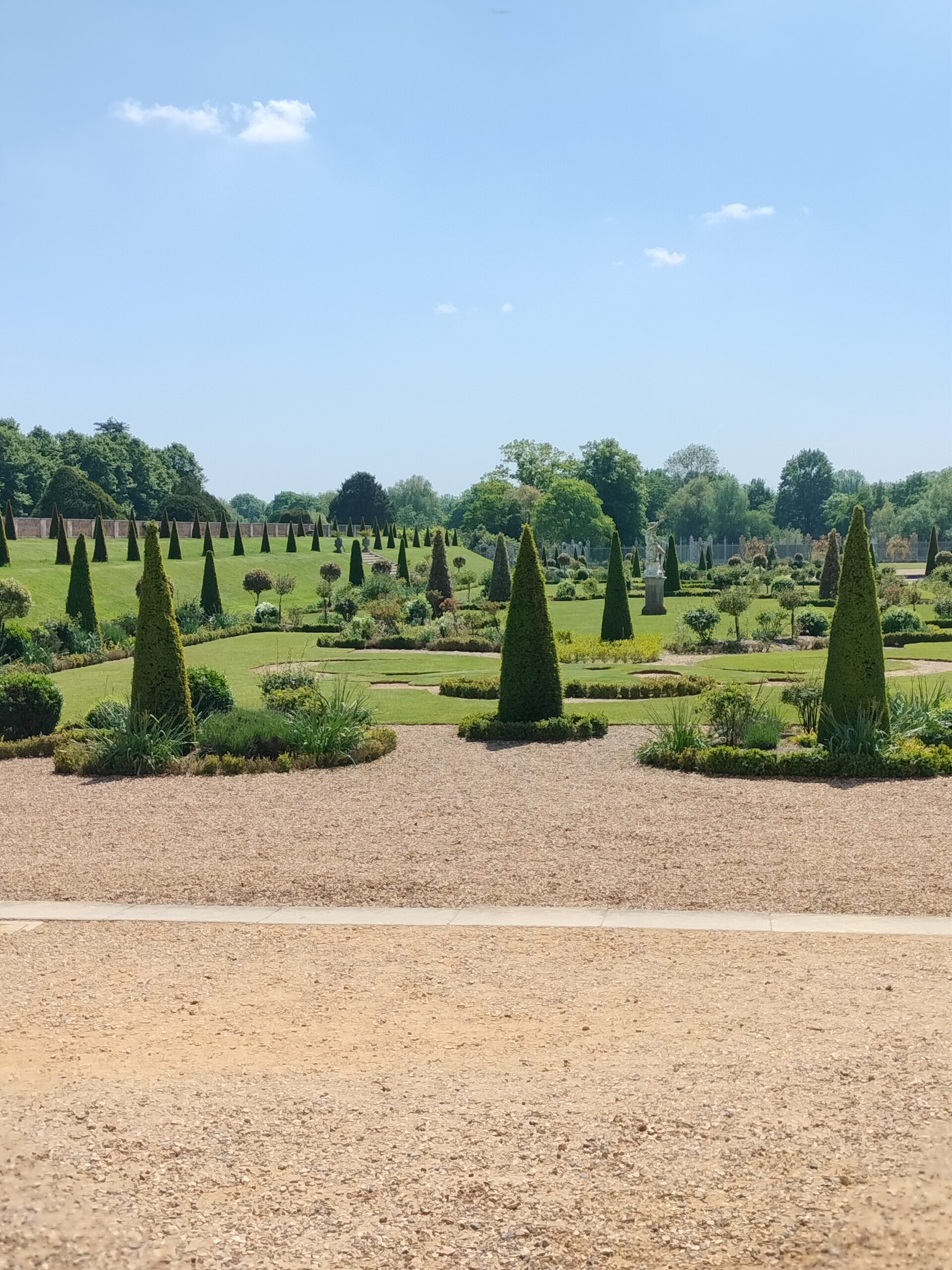
Figure 1: The Privy Garden at Hampton Court is a good example of Baroque garden design. Photograph is author’s own.
The natural world has been a source of inspiration for all forms of art from the earliest of times. Flowers in particular have been illustrated in paintings and textiles for hundreds of years, so it is not surprising that a number of items held in the Royal School of Needlework’s Collection have flowers represented in their designs. Some are very obviously taken straight from nature, while others have been adapted depending on the fashion and the period of time in which they were created.
At the beginning of the 18th century the Baroque style was still very much in vogue. It had originated in Italy and addressed the viewer’s senses directly, appealing to the emotions as well as the intellect. King William III was still on the throne. Queen Mary had died at the end of 17th century but she was well known to have been a fashion setter and collector, particularly of blue and white china. She and William were keen gardeners and had brought their Dutch taste to Britain, influencing pottery, landscape gardening, and interior design. Louis XIV was still on the throne in France. He ruled for 72 years and died in 1715.
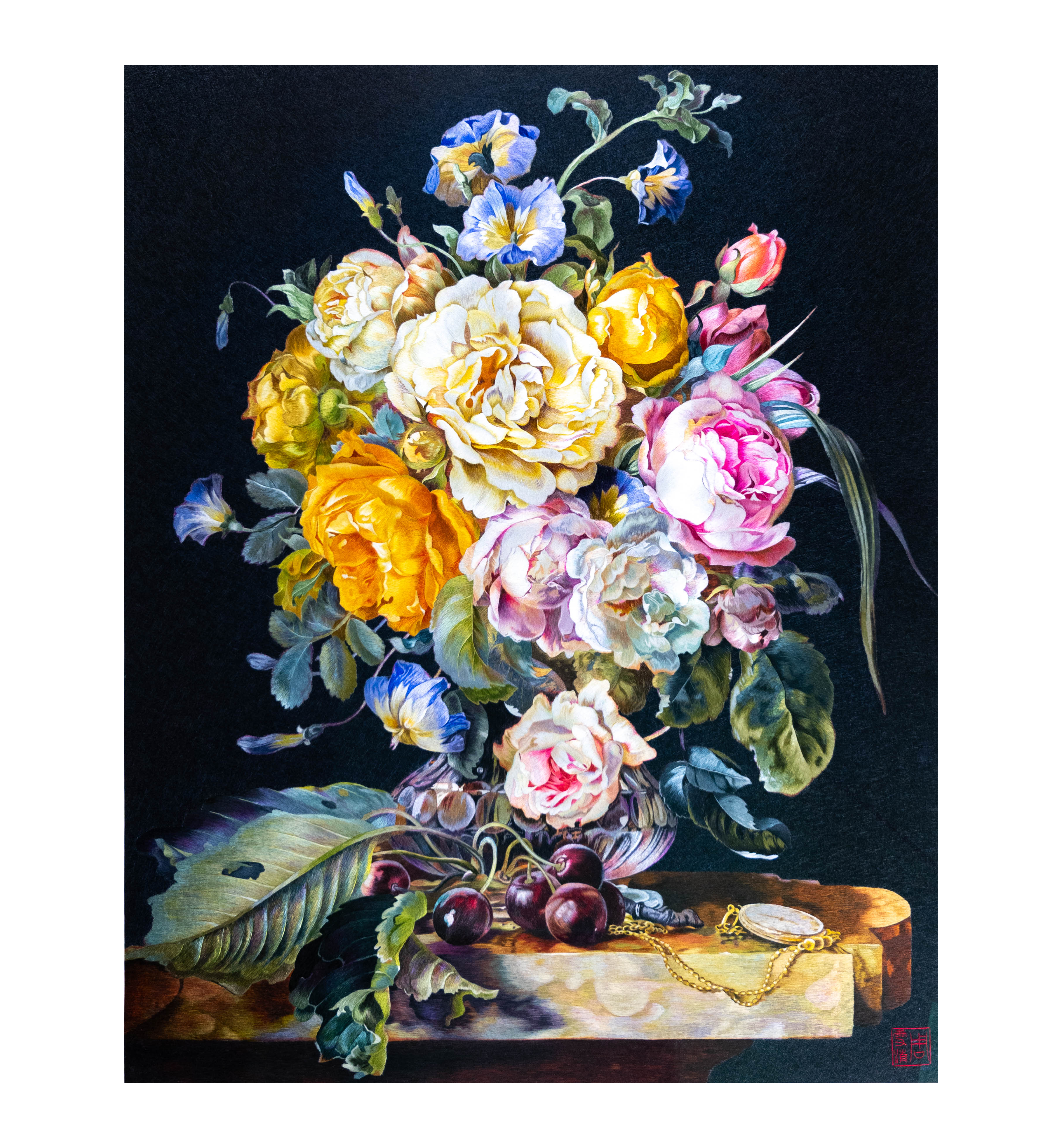
Figure 2: Relevant here is an item from the RSN Collection, COL.2020.56. It is a 21st-century Chinese Silk painting embroidered by Joni Zhou (Zhou Xueqing), based on a 1680 still life painting by Cornelis de Heem.
By the middle of the 18th century, the Baroque style, defined by curving lines, gold, and heavy ornamentation, gave way to Rococo (sometimes referred to as late Baroque). Rococo was characterised by curved asymmetric ornamentation using natural motifs. In 1726 Batty Langley in Practical Geometry Applied to the Useful Arts of Building suggested that flowers in the house should be arranged in a ‘free loose manner, so as not to represent a stiff bundle of flowers void of freedom, in which the beauty of everything consists’. He, among others, heralded a change from the fashion for Baroque to a more naturalistic and irregular style which was known as Rococo. The word is derived from the French word ‘rocaille’, meaning ‘rock work’. This fashion encouraged architecture and objects such as walls, ceilings, porcelain, and furniture to be decorated with scenes and objects from nature including, shells, birds and, of course, flowers. Formal gardens, such as had been fashionable in William and Mary’s reign, were out. These gardens included parterres, borders, and straight avenues. William Kent, who was an architect, furniture designer and gardener, transformed many gardens into Rococo creations, introducing serpentine or crinkle-crankle flower-beds and borders. Rococo would give way to Neoclassicism in the latter part of the 18th century as a reaction to the excesses of Baroque and Rococo styles. Neoclassical art was based on simplicity and symmetry and sought to return to the classical beauty of Ancient Greece and the Roman Empire.
Connecting flowers to symbolism did not become fashionable in Britain until the Victorian era. Shakespeare writes about flowers in several of his plays, poems, and sonnets, but he uses flowers to illustrate his ideas about people rather than likening them to ideas and virtues. And although some flowers were used allegorically in religious art, it is debatable whether the vases of flowers painted by Dutch artists in the late 17th and early 18th century were anything other than beautifully executed paintings of vases of flowers. The earlier pictures featured flat symmetrical arrangements, but over time and certainly by the 18th century the bouquets were more relaxed. They had symmetrical rhythms and overlapping flowers, giving a more naturalistic look to the painting that was typical of Rococo style.
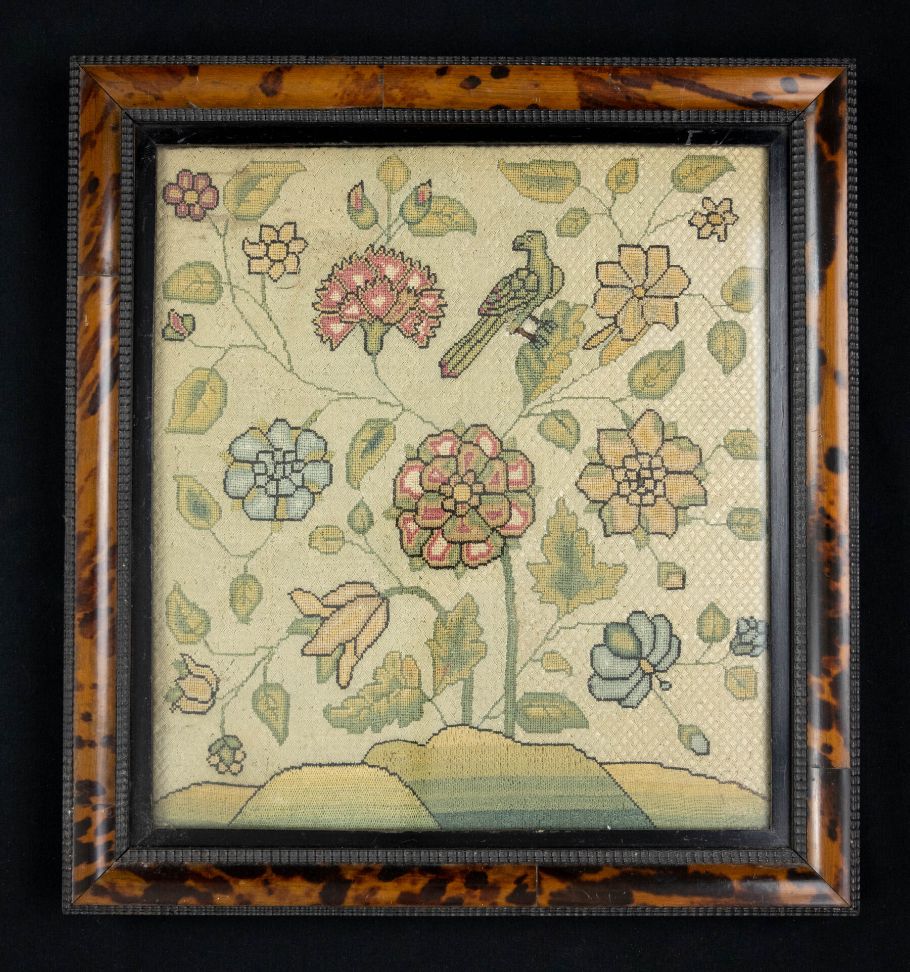
Figure 3: COL.2022.47
This blog post discusses several objects in the RSN Collection that feature flowers. The earliest piece is a circa 1700 embroidered picture of a series of flowering stems on a hillock with a bird, possibly a parrot, sitting on a branch (COL.2022.47). All of the floral and faunal motifs are worked in cross stitches in silk thread. The background is worked in white silk threads in a pattern of pavilion stitches that cover the entire linen ground. The four hillocks involve several canvaswork stitches, specifically brick, a variation on oblique Gobelin, and what seems to be a series of horizontal straight stitches worked at random lengths. Tent stitch and cross stitch embroidery had come back into fashion for furnishings at the end of 17th century, as it proved quick to complete and hard wearing.
Some of the flowers are easily identifiable, such as the carnation and the tulip. The others are more stylised and might well have been influenced by Indian chintzes imported into Europe in the 17th century. Originally, floral patterns on Indian textiles and other media in the 17th century followed the style of book decoration, with single, naturalistically drawn flowering plants. Towards the end of 17th century the flowers became more stylized. This RSN embroidery seems to be copying a Tree of Life motif, a symbol which has been synonymous with mythological, religious, and philosophical traditions. The natural movement in the stems is typical of the Baroque style, with its emphasis on light and its effects and a focus on the theatrical.
The second object of focus in the RSN Collection is a reproduction of a mid-18th-century woven textile (COL.1996.34). The original fabric is held at the Victoria and Albert Museum (T.171-1965). It was possibly designed by John Vansommer (1705-1774), a Huguenot. John Vansommer was the son of Paul Vansommer who came to England and became an engraver. Paul probably had to flee France after the Edict of Nantes was revoked by Louis XIV in 1685. The edict had provided religious tolerance as well as civil rights for the Huguenots, members of the French Protestant church, living in France. John Vansommer was apprenticed to Joseph Danridge (1665-1747), a famous silk weaver and designer who also a natural history illustrator and an amateur naturalist.
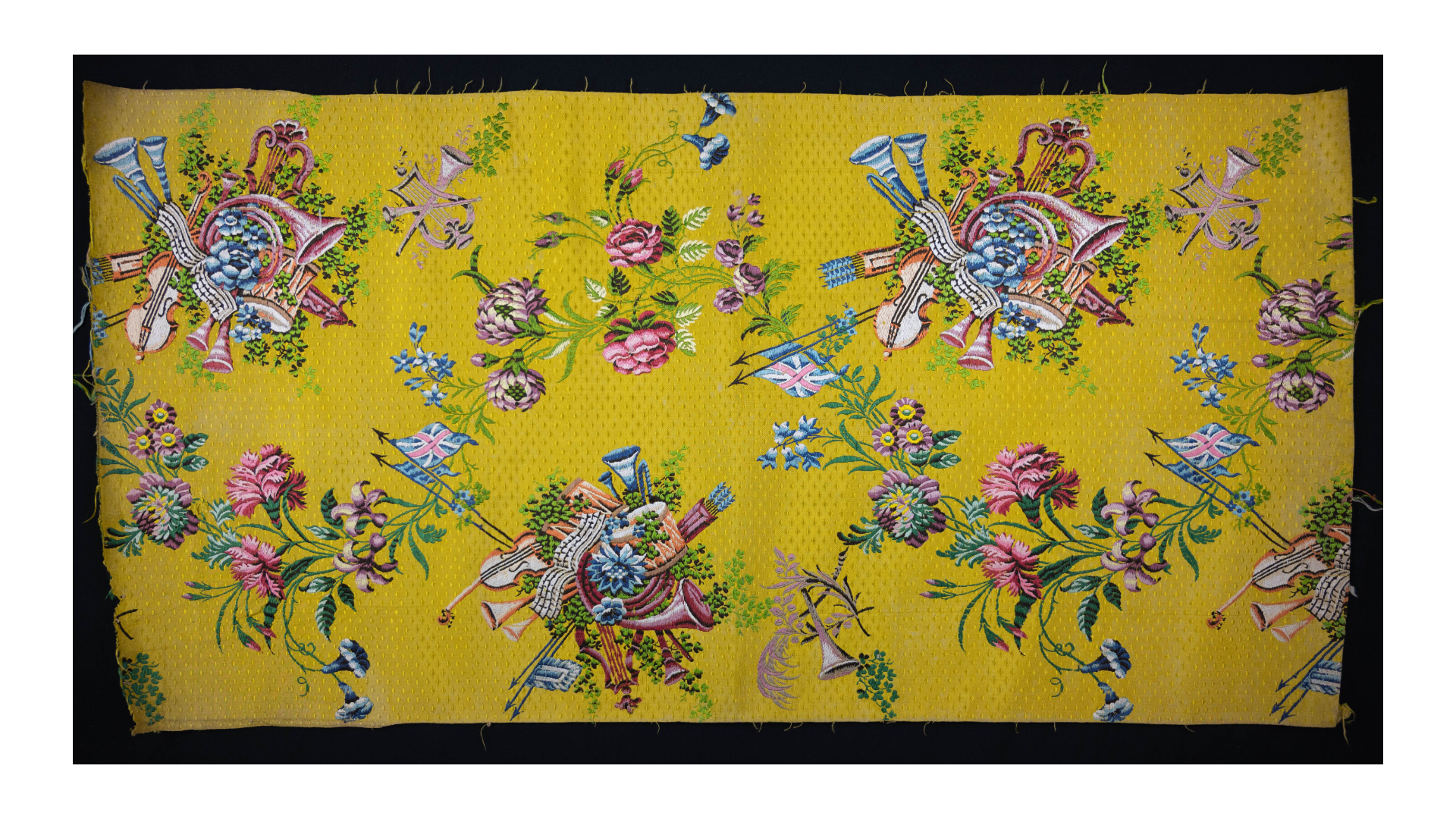
Figure 4: COL.1996.34
A large number of Huguenots ended up in London in the area around Spitalfields, east of the City of London. They brought their incredible craft skills with them, as well as their love of flowers. The particular flower associated with the Huguenots is the auricula, but it was just one of the eight ‘florist’ flowers, which included hyacinths, tulips, ranunculus, anemones, carnations, pinks, and polyanthus, which they cultivated in their back gardens. Sevres porcelain painters, like their Spitalfields silk weaver counterparts, are believed to have grown flowers in the factory garden so that they could study them from real life. The name ‘florist’ was adopted in 1623. The 17th-century meaning of the word is very different to today’s definition. In the late 17th century it was a description of an enthusiast who nurtured and exhibited pot-grown flowers such as tulips and carnations. Working at home, as the Spitalfields weavers did, allowed keen growers to take their plants inside and outside depending on the weather conditions.
The 18th century was a time when there was a thirst for knowledge, particularly scientific. In the 17th century, botany, the study of plants, had emerged out of natural history to become an independent science. The breeding of flowers with particular traits was very much encouraged within florist societies. These societies flourished, helped by the growth and popularity of newspapers, which published information about their meetings. This eventually led flowers to be grown for exhibition. Qualities most sought after in flowers were firstly those with stripes, speckles, or spots of dark colour on paler petals, secondly double flowers, and thirdly flowers with strong scents.
In the early 1700s silk weaving patterns were referred to as ‘bizarre’ because of their strange shapes and combinations of motifs. Often they would feature tropical fruit and foliage; the pineapple was a popular motif. These designs were influenced by the plants which were at that time being discovered in Australasia and the Americas and being brought to Europe. The ‘bizarre’ silks were an attempt to produce botanical naturalism rather than purely conventional floral motifs. The introduction of skirts stretched over wide hoops lead to demand for larger patterns.
By 1742, heavy forms were replaced by a new naturalism that broke from its stylistic predecessors. These distinctly English patterns featured floral sprigs – often identifiable flowers such as carnations and auricula – scattered over a pale ground. They reflected the English love of gardens and remained popular throughout the 1740s and early 1750s. In the mid-1750s patterns still featured light arrangements but with motifs woven in metals threads acting as foils to flowers.
The length of fabric in the RSN Collection has a very vibrant yellow background, but the motifs of flags, musical instruments, arrows, spears, and flowers are a direct copy of John Vansommer’s original. The swags of flowers feature a number of the ‘florist’ flowers, including carnations, auriculas, anemones, and hyacinths. For what occasion it was originally created is a mystery, but the flag and spear motifs are interesting and possibly noteworthy, as are the collection of musical instruments.
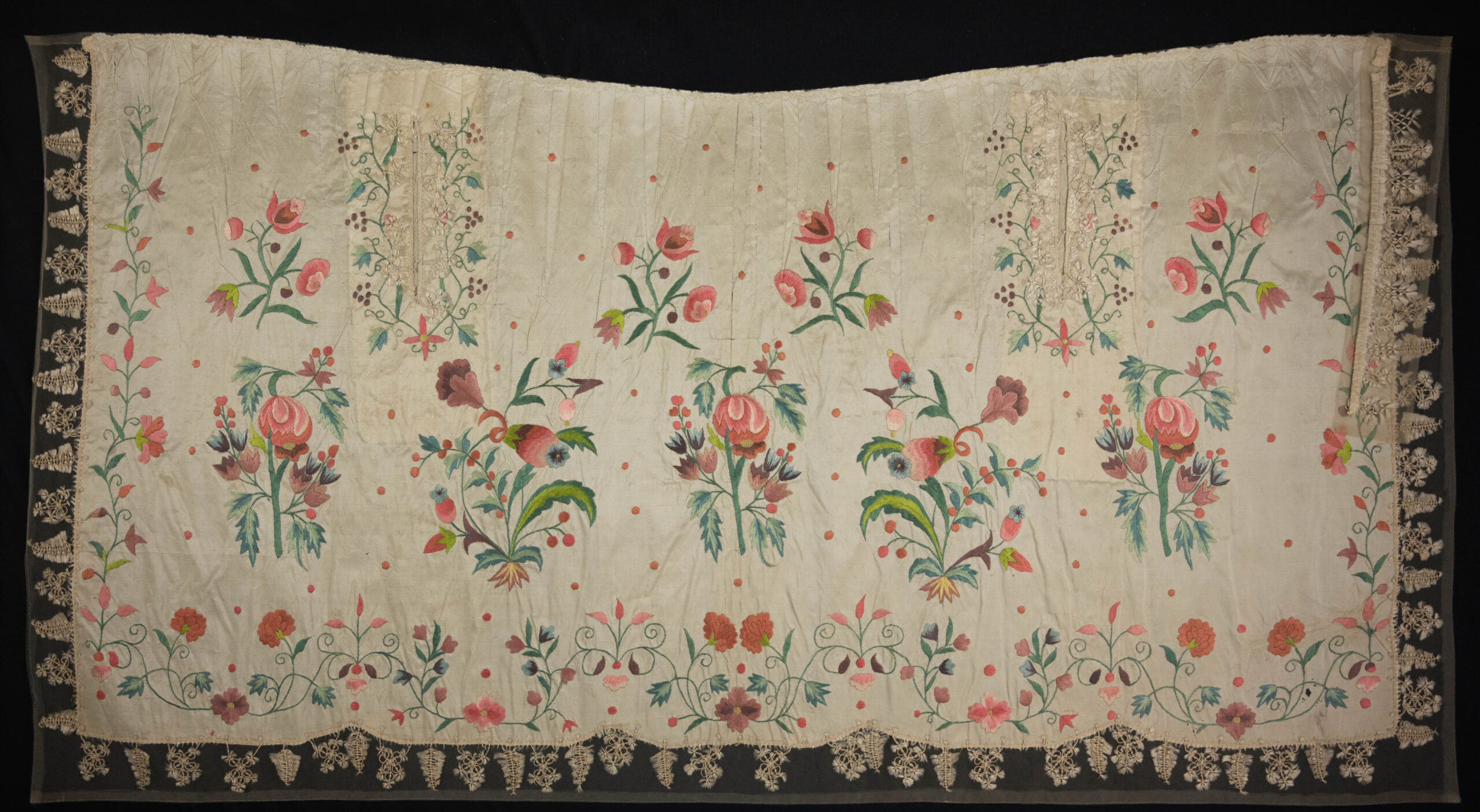
Figure 5: COL.1969.83
The third RSN object of study is a 1730-1760 silk embroidered apron (COL.1969.83). White or heavy duty aprons were traditionally worn by working women and housewives, but wealthy women seem to have adopted them in the 18th century as all things rural and naturalistic influenced fashion. Women of means could purchase professionally embroidered aprons or they could embellish aprons with embroidery themselves. Some women even presented aprons to friends as gifts. The apron owned by the Royal School of Needlework is heavily embroidered and has very stylised floral motifs, a nod towards Indian chintz perhaps. The flowers at the top of the apron resemble tulips and those on the bottom edge carnations. It has a fly fringe which was a type of trimming found on women’s clothing most commonly in the third quarter of 18th century. It was a form of braid using cord and floss silk wrought by members of the passementerie trade (known in Britain as parchmentry) and sold by the haberdasher or even made domestically by non-professionals.
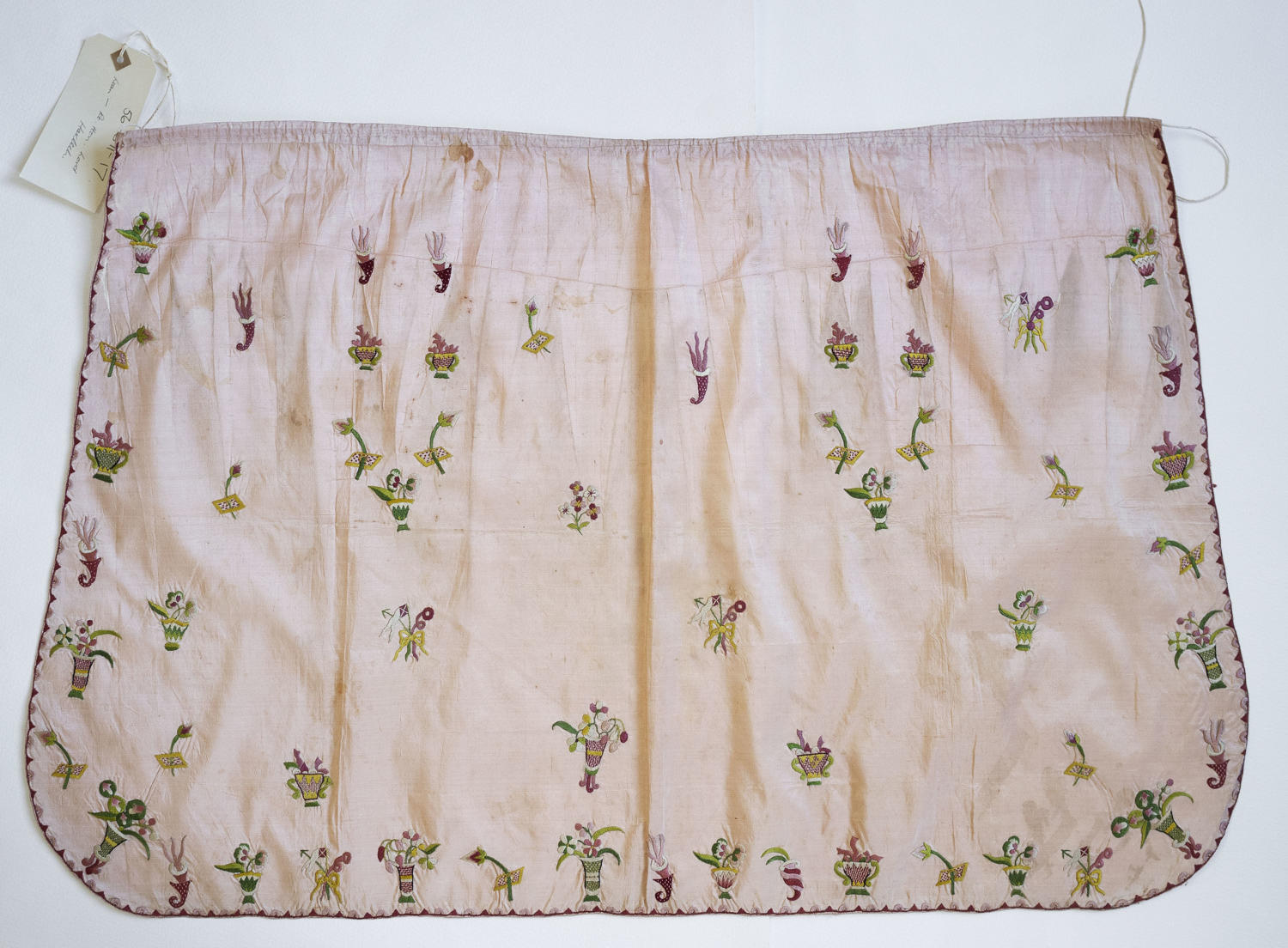
Figure 6: Apron from the estate of Lord Harlech at Glyn Cywarch, North Wales.
An explanatory note in Frances Burney’s Evelina (published in 1778) provides a definition specific to the eighteenth century: ‘aprons were part of all but full evening dress, and ranged from working garments to “dress aprons of silk with rich embroidery in coloured silks and silver thread and foil or finely embroidered and lace-trimmed muslin”’ (Burney, 423).
Catherine Douglas, Duchess of Queensbury, who was a central figure in high society during the 1700s was fond of wearing an apron. A portrait of her by Charles Jervas is a testament to this. However, according to Oliver Goldsmith, Beau Nash, the master of ceremonies at Bath, once took the apron from her and threw it away, saying that only ‘Abigails’ (maids) wore aprons.
An apron sold at auction by Bonhams in 2017 from the estate of Lord Harlech at Glyn Cywarch, North Wales, is embroidered with small motifs including flowers, cards and flags. The flag is similar to the ones used on the fabric designed by John Vansommer. It has since been sold by Jenny Sargeant, a dealer of antique lace and textiles.
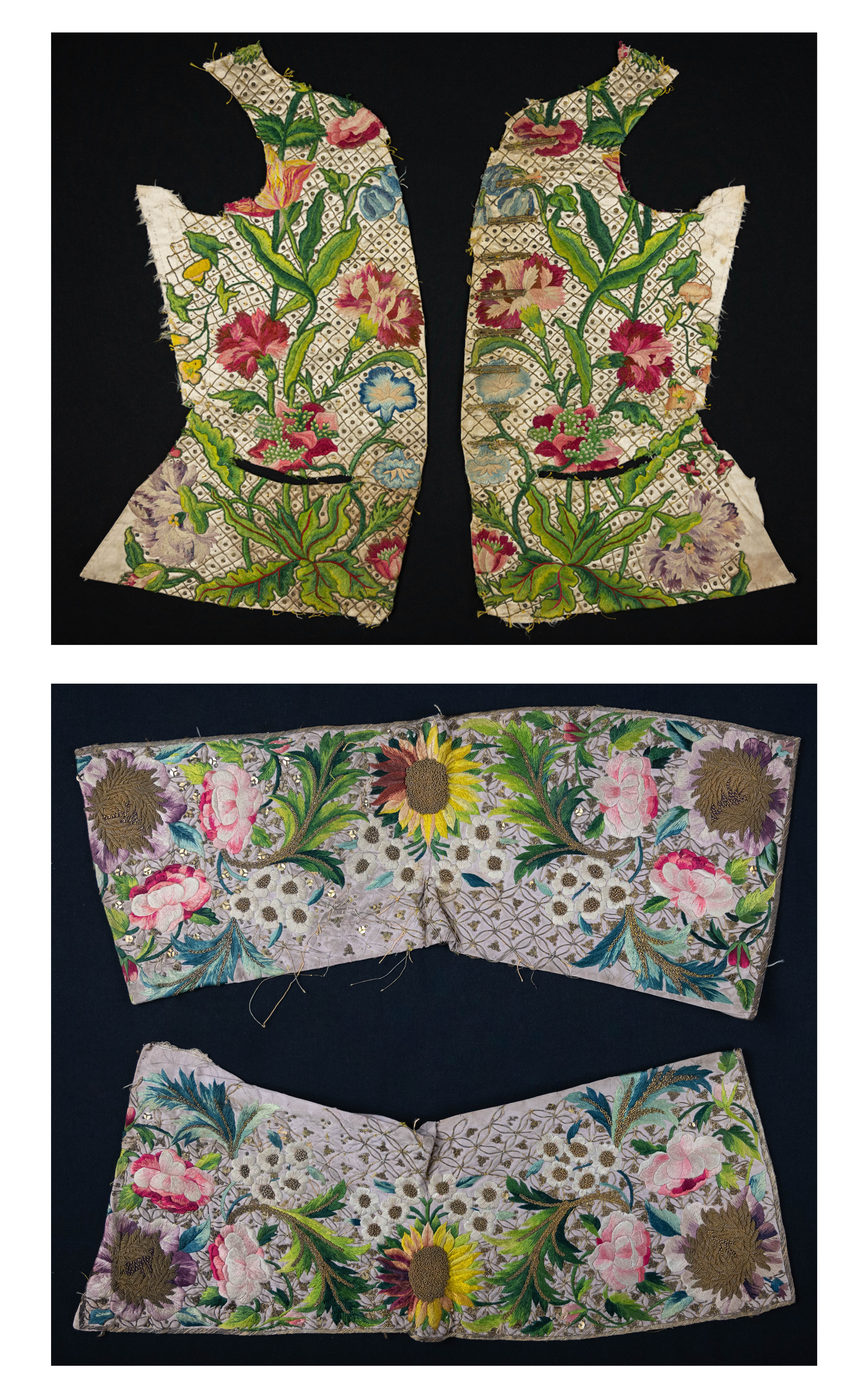
Figure 7: COL.2022.39.a-b
The final two RSN Collection items are also both fashion related. They are a stunning embroidered waistcoat and pair of cuffs owned by Sir Danvers Osborn (1712-1753) (COL.2022.39.a-b, COL.2022.63.a-b). We are lucky to have the provenance for these two pieces. Portraits of Sir Danvers Osborn show that he was a stylish dresser, wearing coats which were richly embellished and which had the wide cuffs fashionable at the time.
The waistcoat (made 1745 to 1750) has been modified, probably in the 19th century and probably for women’s fancy dress. Men’s waistcoats in 1740s were traditionally long and often sleeved. The embroidery is composed of large flowers and leaves, a typical pattern in the late Baroque period. The flowers are identifiable; they include carnations, hyacinths, convolvulus, and tulips and are worked in silk thread in long and short stitch. The waistcoat is further embellished with metal threads and spangles.
Men’s cuffs of this type were valuable and therefore detachable. Usually the cuffs on a coat were wide and would reach half way between the wrist and elbow. The cuffs are an exact match to a waistcoat also worn by Sir Danvers Osborn, conserved by the RSN Studio. Osborn is seen wearing the waistcoat in a portrait by Jeremiah Davison still in family hands. In it, Osborn is listed as being 30 years old, dating the portrait to 1745 or thereabouts. It can therefore be assumed that the waistcoat and the coat the matching cuffs would have originally been a part of were produced around that time. Again, the pink flowers are worked in silk thread in long and short stitch. The petals of the sunflowers are embroidered in directional satin stitch with pearl purl centres. Sunflowers, rare on early modern English embroidery, can be seen on both the waistcoat and the cuffs.
Figure 8: COL.2022.63.a-b
Sunflowers had been brought to Europe by the Spanish from South America. They were venerated by the Inca as the sacred image of their sun-god. The sunflower, when in bud, is heliotropic, which means it will track the sun from east to west during the day. The open, mature flower faces east. It is interesting to see the sunflowers on these cuffs. Perhaps they were included because of Sir Danvers’ ties to the Americas.
Numerous flowers were imported into Britain from America and Australia during 18th century. In fact, Mary Delany, the embroiderer, botanist, designer of grottoes, and artist who has become well known for her detailed and botanically accurate depictions of plants using tissue paper and hand colouration, was often given newly discovered plants to copy.
The 18th century had its fair share of change and upheaval. This was reflected in the areas of design and art. But throughout these changes, flowers continued to be depicted, whether it was in the large bizarre designs for silk in the early 18th century or the revival of wreaths and garlands as a nod to Greco-Roman antiquity heralding the neoclassical period. Flowers were celebrated in textiles and embroidery throughout the century.
Relevant links:
I would like to thank Jenny Sargeant for giving permission to use her pictures of the 18th-century apron. It can be viewed here: https://www.jennysargeant.com/en-GB/antique-textiles/18th-century-embroidered-silk-apron-with-provenance/prod_10092.
An exhibition at Strawberry Hill House focuses on two 18th-century paintings of flowers by Jan van Huysum. The exhibition is on until 8 September 2024. More information can be found here: https://www.strawberryhillhouse.org.uk/jan-van-huysum-exhibit/.
Bibliography:
‘1700’S’. Historical Menswear. https://www.historicalmenswear.com/1700s/.
‘18th Century Embroidery Silk Apron with provenance’. Jenny Sargeant.
Beck, Thomasina. The Embroiderers’ Story: Needlework from the Renaissance to the
Present Day. David and Charles, 1995.
Blacker, Mary Rose. Flora Domestica: A History of British Flower Arranging, 1500-1930.
Harry N. Abrams, 2000.
Crill, Rosemary. V&A Pattern: Indian Florals. V&A Publications, 2020 revised edition.
Duthie, Ruth. Florists’ Flowers and Societies. Shire Publications, 1988.
Hart, Avril and Susan North. Historical Fashion in Detail: The 17th and 18th Centuries. V&A
Publications, 2000.
Kerr, Jessica. Shakespeare’s Flowers. Kestrel Books, 1969.
Lehner, Ernst and Johanna Lehner. Folklore and Symbolism of Flowers, Plants and Trees.
Martino Publishing, 2012.
Pavord, Anna. The Tulip. Bloomsbury, 1999.
Scott-James, Anne and Osbert Lancaster. The Pleasure Garden: An illustrated History of
British Gardening. John Murray, 1977.
Spencer, Elizabeth. ‘“None but Abigails appeared in white aprons”: The Apron as an Elite
Garment in Eighteenth-Century England’. Textile History 49, no. 2 (2018): 164-190.
‘Textile’. Victoria and Albert Museum.
https://collections.vam.ac.uk/item/O258709/textile-unknown/.
Thunder, Moira. V&A Pattern: Spitalfields Silks. V&A Publications, 2011.
Williamson, Tom. Polite Landscapes: Gardens and Society in Eighteenth-Century England.
Sutton Publishing, 1995.
